0 Introduction
The power grid is an important infrastructure for promoting national economic and social development. The current grid composition is increasingly complex, and with the continuous construction of ultra-high-voltage grids, large grid interconnections, and grid coupling, the globalization of a local fault impact is becoming increasingly prominent.Additionally, with the large-scale access to wind power,photovoltaics, and other new energy sources, the capacity for power-grid regulation has decreased significantly,grid stability has become increasingly complex, and fault handling has become more challenging. The requirements of grid fault handling on the comprehensive business ability of regulators are increasing, requiring the provincial regulator on duty to have a global mentality of collaborative processing with the state and other provinces and the ability for vertical connection through provincial, local, and county grids. When a fault occurs, the regulator must promptly identify the cause of the fault, monitor important parts of the grid and key nodes in real time, analyze the weak points of grid operation, and take measures to restore power supply. However, the current power-grid dispatch system is primarily based on monitoring, analysis, and decisionmaking; thus, it heavily relies on dispatcher knowledge and historical experience. To handle faults, dispatchers are required to memorize many stability regulations, safety control protection regulations, operation regulations, and contingency plans in text form. Not only is some text easy to miss and the process has low efficiency, but also passing on and sharing this experience and ability is difficult. The fault-handling mode is unstable and non-standardized and cannot adapt to the new requirements of grid development.
To improve the power-grid pre-, in-, and post-processing capabilities, and to support the construction of new power systems, the level of grid fault-handling intelligence must be improved. A knowledge graph is an artificial intelligence tool and a structured semantic knowledge base that can construct and query complex association relationships,understand user usage at the semantic level, and improve the quality of knowledge construction and management.Domestic scholars have conducted research on general knowledge graph technology [1,2] and have proposed methods of constructing domain knowledge graphs and techniques to extract knowledge for power grid dispatch[3-5]. For example, entity extraction methods based on the BILSTM_CRF model have been proposed [6], knowledge graphs have been applied in distribution network fault-aided decision-making [7], power equipment health management[8], power transformer fault prediction [9], and power equipment defect record retrieval methods [10]. In 2022,the pre-trained language model BERT was used to enhance the semantic representation of words [11]. Compared with Google’s BERT, Baidu’s ERNIE can obtain more semantic information based on the Chinese corpus. Some scholars have conducted research on Chinese named entity recognition (NER) based on ERNIE pre-trained [12,13] and applied it to text mining of power equipment defects [14],which shows that ERNIE can improve model accuracy.
In this paper, based on the business requirements of power-grid dispatch fault-handling auxiliary decisionmaking and fault-disposal multi-source heterogeneous data,a joint entity–relationship extraction method based on a pretrained model is proposed to construct the ERNIE-BiLSTMCRF model for knowledge extraction of power-grid faulthandling entities and relationships. The ontological model of the grid dispatch fault-handling knowledge graph is designed by combining the dispatcher’s business experience with grid dispatch multi-source heterogeneous data. The overall architecture of the knowledge-graph-based powergrid dispatch fault-handling auxiliary decision system is designed, technology selection is performed, and the system is developed. The system was applied to a provincial dispatch control center, effectively improving the accidenthandling capability and enhancing the intelligence level of power-grid accident control.
1 Research on knowledge extraction techniques based on pre-trained models
1.1 Entity identification model
The entity recognition of domain-unstructured data is a difficult task in entity recognition technology. NER based on the conditional random field (CRF), bidirectional long short-term memory (BiLSTM), and convolutional neural network (CNN) has achieved excellent results [15-19]. The CRF is a discriminative model that is widely used in natural language processing (NLP) sequence-labeling tasks and achieves excellent results. BiLSTM has a strong sequence modeling ability to obtain back-and-forth information, and the neural network can fit nonlinearities well.
(1) CRF model
The CRF attempts to model the conditional probabilities of multiple variables for a given observation. Let x={ x1 , x2, …,xn} be the sequence of observations and y={ y1 , y2, …,yn} be the corresponding sequence of markers. The aim of the CRF is to construct a probabilistic model P (y x| ).
![]() denotes the undirected graph with elements in the node marker variables y corresponding one-to-one,yv denotes the marker variables corresponding to node v,and n(v) denotes the neighboring nodes of node v; if each variable yv of the graph G satisfies Markovness, i.e.,
denotes the undirected graph with elements in the node marker variables y corresponding one-to-one,yv denotes the marker variables corresponding to node v,and n(v) denotes the neighboring nodes of node v; if each variable yv of the graph G satisfies Markovness, i.e.,
then (y ,x ) constitutes a CRF.
In the CRF, by selecting the exponential potential function and introducing the feature function, the conditional probability is defined as
tk are feature functions defined on edges, called transfer features, which depend on the previous position, and sl are feature functions defined on nodes, called state features,which depend on the current position. tk and sl are both position-dependent local feature functions. The CRF is completely determined by the feature functions tk sl and the corresponding weights λk and µl.
Let P (Y | X ) be a linear CRF; thus, the conditional probability of the random variable Y that takes the value of x has the following form under the condition that the random variable X takes the value of y:
where
where tk and sl are the feature functions, and λk and µl are the corresponding weights. Z (x ) is the normalization factor, and summation is performed over all possible output sequences.
The CRF can also be represented in simplified form.First, the transfer features, state features, and their weights are represented using a uniform notation. Using K1 transfer features, K2 state features, and K = K1 +K2,

Subsequently, the transfer state features are summed at each position i and denoted as
The weights of feature f k( y , x ) are denoted by wk, i.e.,
Thus, the CRF (4)—(5) can be expressed as

If the weight vector is denoted by w, i.e.,
The global feature vector F (y, x) is
The CRF can then be expressed as the inner product of the vectors w and F (y, x:
where
The CRF model is a log-linear model defined on timeseries data, and its learning methods include maximum likelihood estimation and regularized maximum likelihood estimation. The specific optimization implementation algorithms are the improved iterative scaling (IIS), gradient descent, and Newton methods.
(2) BiLSTM model
The LSTM is a special recurrent neural network [20],and the specific implementation of the LSTM unit at time t is updated using Equations (14—19).
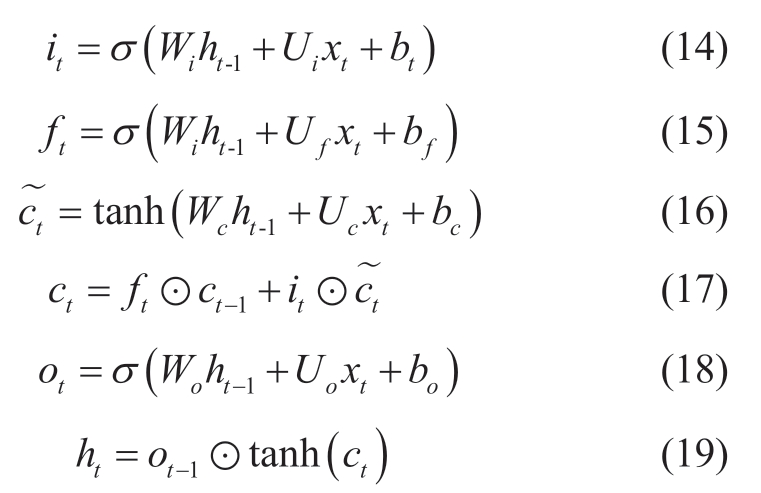
where σ is the sigmoid function, and ʘ is the corresponding product of the elements. xt is the input vector at time t, and ht is the implied state vector, also called the output vector. Ui,Uf, Uc, Uo are the “input gate,” “forget gate,” “unit gate,” and “output gate” weights of the input vector xt, respectively; Wi,Wf , Wc, and Wo are the weights of the respective gates on the implied state vector ht; bt, bf, bc, and bo are the bias vectors.
Fig. 1 shows the structure of the BiLSTM, which adds reverse computation compared with LSTM, fully utilizes the before and after text information, and obtains all the information of the sequence using forward and reverse computation, which can be applied to multi-class NLP tasks[21-24].

Fig. 1 BiLSTM model
1.2 Relationship Extraction Model
Relationship extraction (RE) is the extraction of relationships between entities from text data, generally in the form of a triad (subject–relationship–object). RE consists of two tasks: identifying the subject and object in the text, which is a named entity identification task, and determining the relationship type between the subject and object, which is a relationship classification task. Current mainstream RE methods include the pipeline and joint extraction approaches.
The pipeline approach decomposes RE into entity identification and classification tasks. The entity identification task labels entities such as subjects and objects, whereas the classification task classifies the relationships between entities. Pipeline tasks are sequential and cause error propagation, i.e., the error in the next task at the time of prediction is affected by the error in the previous step. Thus, the error in entity recognition is transferred to the relationship classification task; however, the relationship classification task cannot optimize the error caused by entity recognition. To address this problem, various joint extraction methods have been developed.
The joint extraction approach can be understood as a multi-task approach that simultaneously performs NER and relationship classification tasks, which directly outputs the subject–relationship–object triad contained in the text by modifying the labeling method and model structure. The joint extraction approach involves an interaction between the representations of the two tasks to assist in the learning of the tasks. The training and prediction are not different because multiple models do not have to be trained, as in the pipeline approach.
In this paper, we adopt a joint extraction method, which is implemented as follows: 1) pre-processing operations,such as cleaning and labeling the grid dispatch text data,to obtain training data; 2) using ERNIE 1.0, a pre-trained model, as an encoder to encode the training text to obtain the serialized output; 3) using the output of ERNIE 1.0 as the input of the BiLSTM-CRF network to jointly train NER and relationship classification tasks. The output of the model is a table composed of text sequences, as shown in Fig. 2. The positions in the table indicate the connection relationships between the entities and attributes of each entity. This results in an output of both NER RE.
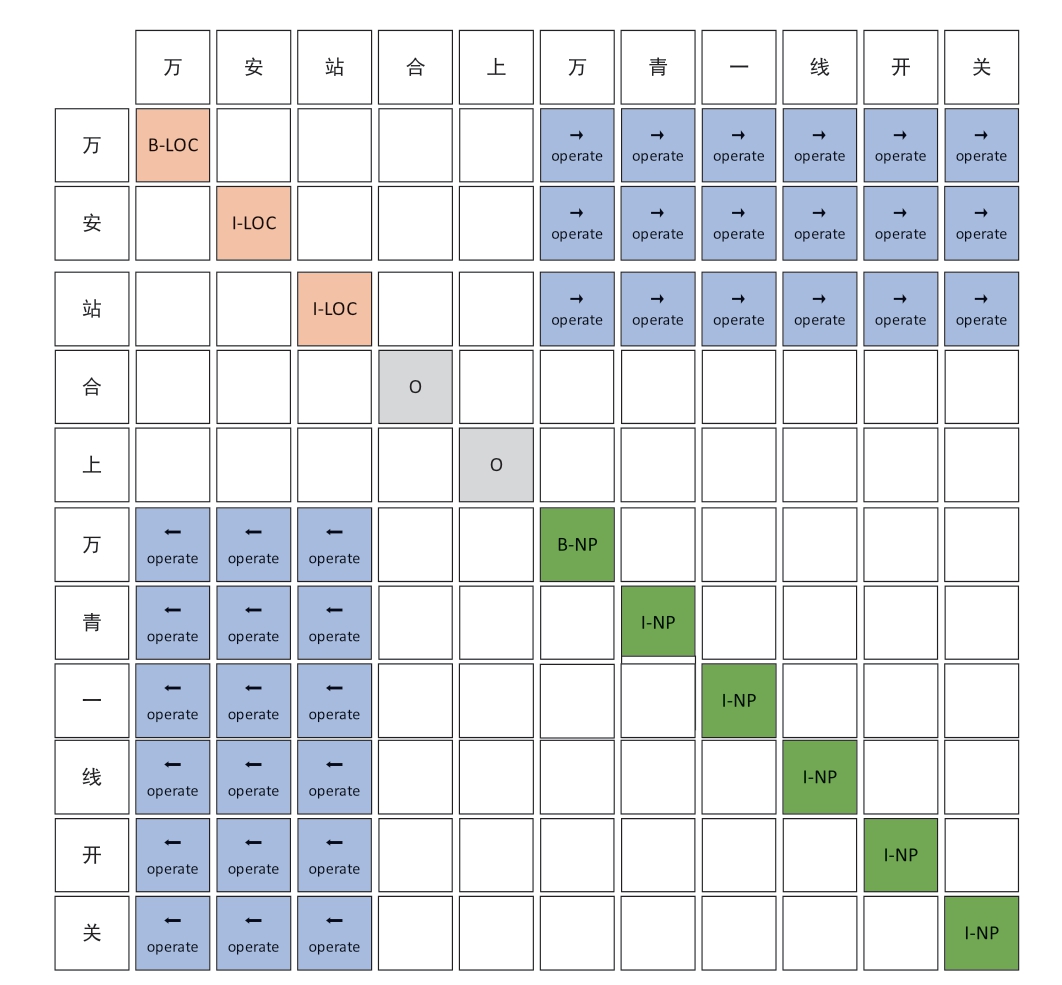
Fig. 2 Sample output of the RE model
1.3 Joint entity–relationship extraction method based on the pre-trained model
Pre-trained models are models that are trained from a large unlabeled corpus to obtain the grammatical, syntactic,and semantic features of a natural language. Models trained with a large unlabeled corpus can learn the general rules of natural language, have good generalization ability, and better assist in downstream tasks. The migration of pretrained to downstream tasks provides a more suitable initial parameter base, which enables the model to be trained without beginning from scratch, accelerates the convergence of the model training process, and mitigates the degree of overfitting in training on small datasets.
ERNIE is an open-source pre-trained model developed by Baidu that is more suitable for Chinese pre-trained than BERT. Based on the pre-trained model ERNIE 1.0,this paper constructs the ERNIE-BiLSTM-CRF entity–relationship knowledge extraction model for power grid dispatch that integrates the advantages of the BiLSTM and CRF models, as shown in Fig. 3. The model first performs ERNIE encoding on labeled data and then uses the BiLSTM and CRF to perform sequence labeling and obtain the labeled results of each character to complete the task of entity and relationship extraction.
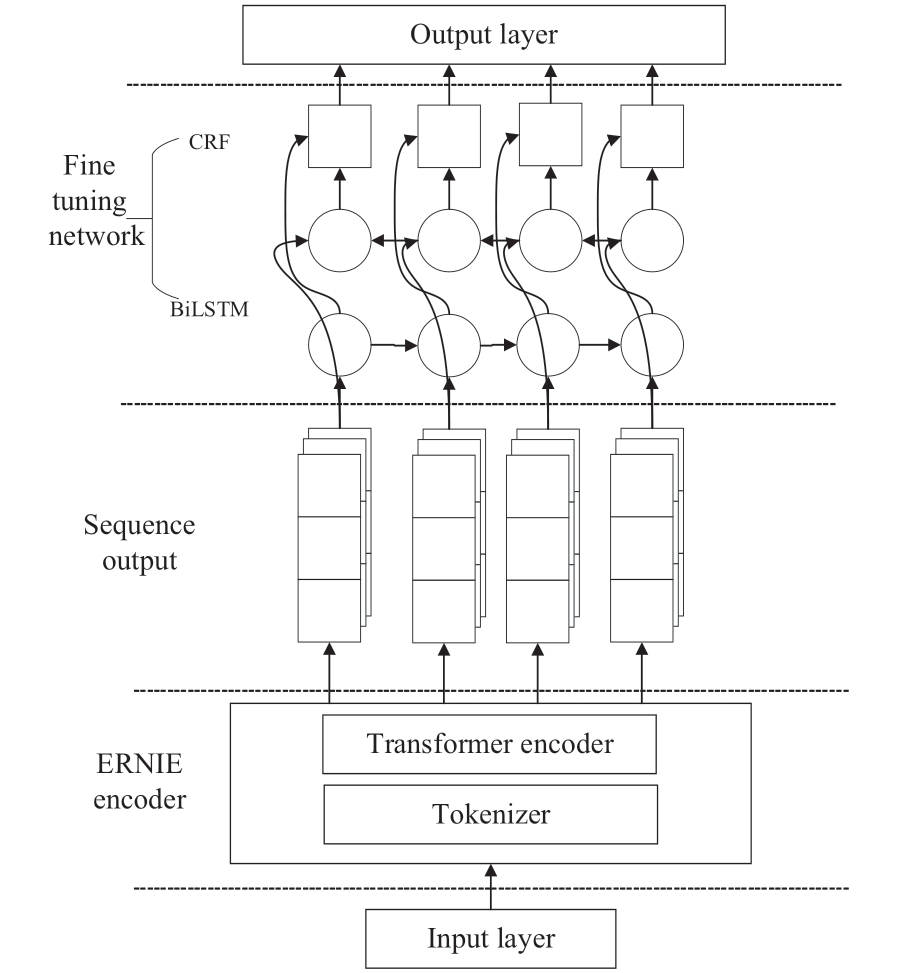
Fig. 3 Joint extraction model of entities and relationships
2 Research on the method of constructing knowledge graphs of power grid faults
2.1 Grid Troubleshooting Corpus
The grid dispatch fault-disposal data primarily includes equipment ledgers (including lines, busbars, main transformers, generators, and switches), equipment status,tide data, comprehensive intelligent alarm data, monitoring message information, optical character plate information,fault recording files, dispatch regulations, dispatch rules,and dispatch accident plans.
(1) Structured and semi-structured data are primarily obtained from the grid dispatch control cloud platform,D5000, and other systems that contain the equipment ledger and equipment operation monitoring real-time and alarm data. This type of data contains the topology of the powergrid equipment and its operational status.
(2) Unstructured data are primarily dispatch regulations,dispatch rules, dispatch accident plans, and historical fault disposal and overhaul data accumulated by the powergrid dispatch control center; they are important reference documents for dispatchers to handle faults.
Table 1 Power-grid dispatch fault-processing data

2.2 Grid Fault-Handling Knowledge Graph Ontology Modeling
The knowledge graph ontology model OKG can be expressed using equation (20), where T(E) represents a class of entities; the same type of entity E corresponds to a class of objects, such as lines of different voltage levels (35 kV,10 kV, etc.); T(F) represents the same class of attributes,such as bus bars and lines corresponding to different voltage levels; and T(R) represents the same class of relationships,such as the connection relationships between transformers,bus bars, switches, and barrier gates.
In this study, different construction methods were used for different types of data. For structured data, such as grid topology and real-time operation measurement information,the ER model was used to design the ontology model,including “entity-attribute” and “entity-relationship-entity” base models. For unstructured data, such as fault plans and dispatch procedures, the ontology model of the grid faulthandling knowledge graph was constructed in a top-down manner, and the software Protégé was used for the ontology design. Finally, the ontologies of the two categories of data were fused and processed to obtain the ontology model shown in Fig. 4.
2.3 Knowledge Graph Construction for Grid Fault Disposal
(1) Extraction of knowledge elements
The grid fault-disposal corpus data involve multiple sources of heterogeneous data, such as grid equipment topology, real-time equipment operation status, integrated alarms, and fault plans. Knowledge extraction is performed separately for structured and unstructured data.
The structured data of grid dispatch are parsed and filtered using the ontology model of grid dispatch fault handling to extract the knowledge of grid fault disposal,including entity, relational, and attribute knowledge. The method extracts data directly from the relational database,establishes the mapping relationship from the data to a knowledge graph, and completes the extraction of entities such as field stations, transformers, busbars, lines, switches,gates, mechanisms, and generators, as well as the extraction of relationships such as “belonging to dispatch,” “belonging to grid,” “connection,” “belonging to plant station,” “end plant station,” “starting plant station,” and “belonging to power plant.”
For unstructured data, we adopt pre-trained and deeplearning-based methods for knowledge extraction by building a joint entity–relationship extraction model of ERNIE, BiLSTM, and CRF to achieve the knowledge extraction of entities, attributes, and relationships of text data.
(2) Knowledge integration
Knowledge extraction enables the acquisition of entity,relationship, and attribute information from multi-source heterogeneous data; however, the extracted results may contain redundant or incorrect data, and the data may lack hierarchy and logic, which requires knowledge fusion processing.
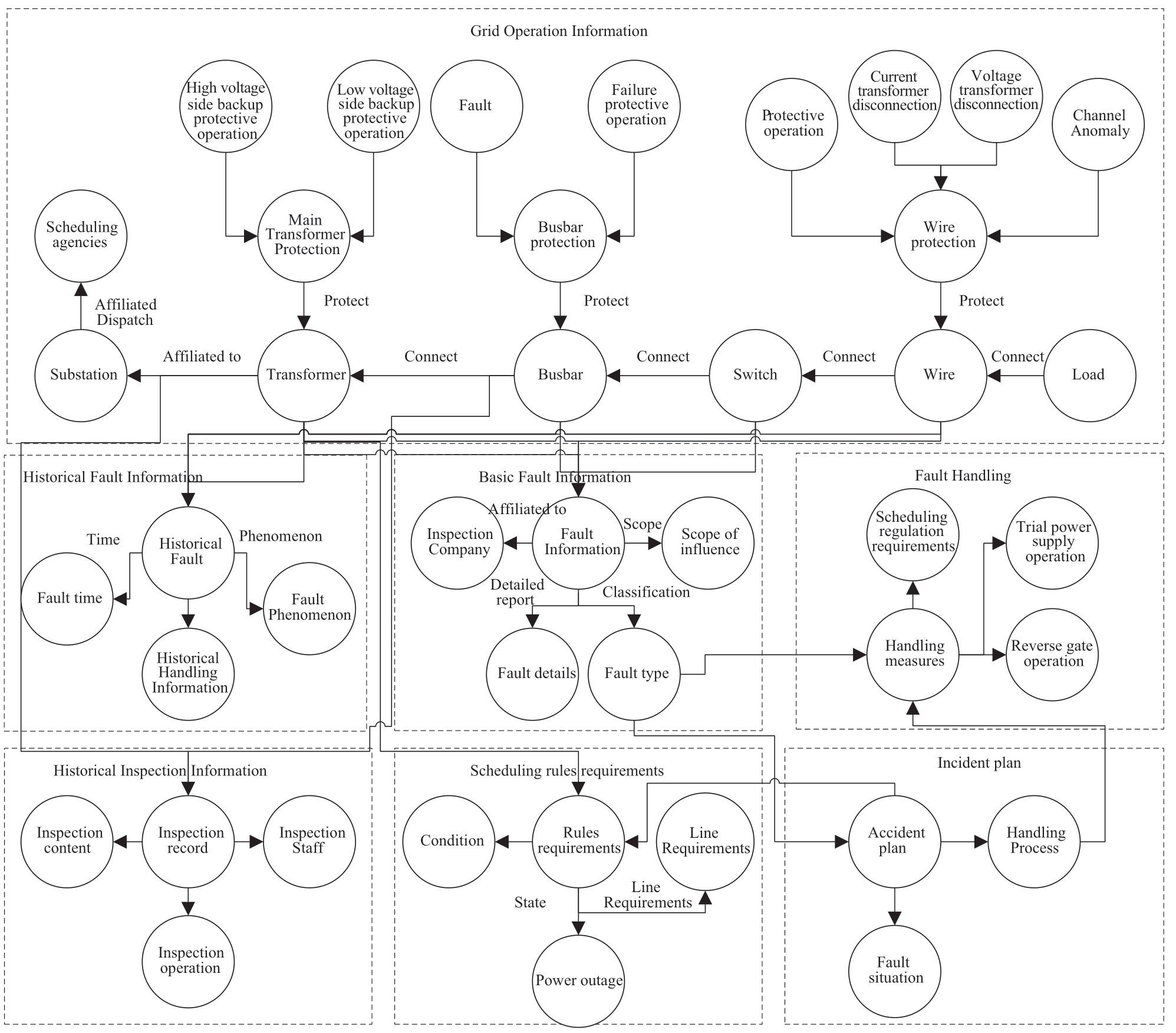
Fig. 4 Knowledge graph ontology model
Entity linking primarily links extracted entities with existing ones, such as linking and aligning the equipment information extracted from the dispatch details and fault plans with the extracted structured equipment information.The problem of the same entity corresponding to multiple entity objects and allegations corresponding to one entity is solved using entity disambiguation and co-reference resolution techniques. In this paper, we primarily combine the contextual information of grid dispatch text and achieve entity linking and co-disambiguation through similarity calculation and co-occurrence techniques, such as whether “transformer #1” is transformer #1 of substation A or substation B, and whether “transformer #1 of Jinanmen Station” and “Jinanmen Station #1 transformer” are the same entity. Similarity calculation primarily uses word embedding technology to vectorize entity strings and then calculates the similarity between vectors. Co-occurrence technology solves the problem of disambiguation between entities and co-referential expressions by considering the contextual information of the surrounding text. The LSTM is used to model the contextual information and identify entities and co-referential expressions.
After the knowledge element extraction and knowledge fusion processes, a knowledge graph of grid fault handling is constructed.
(3) Storage of grid fault disposal knowledge
In this study, we used the graph database Neo4j to store the knowledge of fault entities, attributes, relationships,and events extracted from the grid fault disposal data.Technically, Python was used to write a program for the automated storage of knowledge data in the Neo4j database,to cure grid fault disposal knowledge, and to provide an efficient query interface that can support knowledge retrieval requirements.
When knowledge data are updated, the data update operation program is triggered to store the entities and relationships in the database. The primary considerations for automatic storage are data consistency and integrity. New entities and relationships should be consistent with existing data, and all necessary attributes and relationships should be correctly added to the database. During the application process, data consistency and integrity are achieved by writing the verification logic and using transactions.
2.4 Application of Grid Fault Disposition Knowledge Reasoning
A grid dispatch fault disposal is pushed by a grid dispatch integrated alarm with grid fault information, and the fault disposal module performs information extraction and analysis, reasoning, and calculation based on the knowledge graph to form auxiliary decision-making suggestions for dispatchers’ reference for grid fault disposal.
(1) Comprehensive alarms launch grid fault information,and the power dispatch alarm information consists of short text data, including time, location, alarm content, and status information, where the alarm content contains important information.
(2) Fault key information extraction. The fault disposal module obtains comprehensive alarm fault information,and the fault-information-extraction module extracts key information, such as faulty equipment entities and fault types, through semantic analysis.
(3) Fault information analysis. The fault-informationanalysis module performs knowledge graph queries based on fault equipment information and obtains fault equipmentrelated information, including information on the equipment voltage level, associated equipment, equipment fault history,equipment disposal history, and equipment operation information. Based on semantic similarity, it calculates fault-related dispatch regulations, dispatch rules, fault plans,and other information.
(4) Fault-handling reasoning. Fault-handling rule reasoning and case-based reasoning methods are primarily used. Rule reasoning is primarily for scenarios similar to production rules in dispatch operational procedures and disposal plans, such as restrictions on specified operations or recommended principles. By querying and matching the equipment in the knowledge map, recommended or restricted operation information is obtained, and appropriate disposal methods are selected. Case-based reasoning first constructs several feature descriptions of historical cases,such as the time, location, severity of accidents, and related electrical equipment, to obtain a feature representation of a case. Semantic similarity is then used to calculate the similarity between different cases and identify similar historical cases. Finally, based on the historical processing experience, operational principles or suggestions are provided for this event.
(5) Fault-handling auxiliary decision-making. Based on the results of fault analysis and knowledge reasoning,the system pushes the fault equipment information, fault message information, line information, protection action information, fault handling basis, disposal strategy, and other information to the dispatcher, who checks and corrects the relevant information, forms the final handling method,and handles the faults.
3 D esign of a Knowledge Graph-based Fault-Handling System for Power-Grid Dispatch
3.1 General Architecture
The technical architecture of the power-grid dispatch fault-handling system includes resource, data, service, and application layers.
The resource layer provides the GPU, network, storage,and other resources to support the training and service of the knowledge extraction model.
The data layer includes structured data (relational data such as power grid dispatch network topology, static model data, and real-time data), unstructured data (power grid dispatch protocols, dispatch plans, and historical maintenance fault data), and graph data (power grid dispatch fault-handling entities, relationships, and attributes), which are stored in relational and graph databases.
The service layer includes knowledge extraction,knowledge fusion, and knowledge service, providing entity, relationship, and event extraction, as well as knowledge inference, knowledge search, and intelligent recommendation services to support the business application of grid dispatch fault handling.
The application layer provides the dispatcher with real-time currents, integrated alarms, fault equipment information, fault message information, adjacent line information, relevant protection action information,handling strategy push, fault handling basis, weak-point lines, and nodes.
3.2 System Development
The technical route of the knowledge-graph-based grid fault-handling software system follows the Java EE technology system, and the presentation technology adopts bootstrapping, mxgraph, JSP, JavaScript, and Echarts.Integration with existing business systems is achieved through interface components with data sharing and reuse capability, and deployment through microservices to support grid dispatch fault-handling business applications.
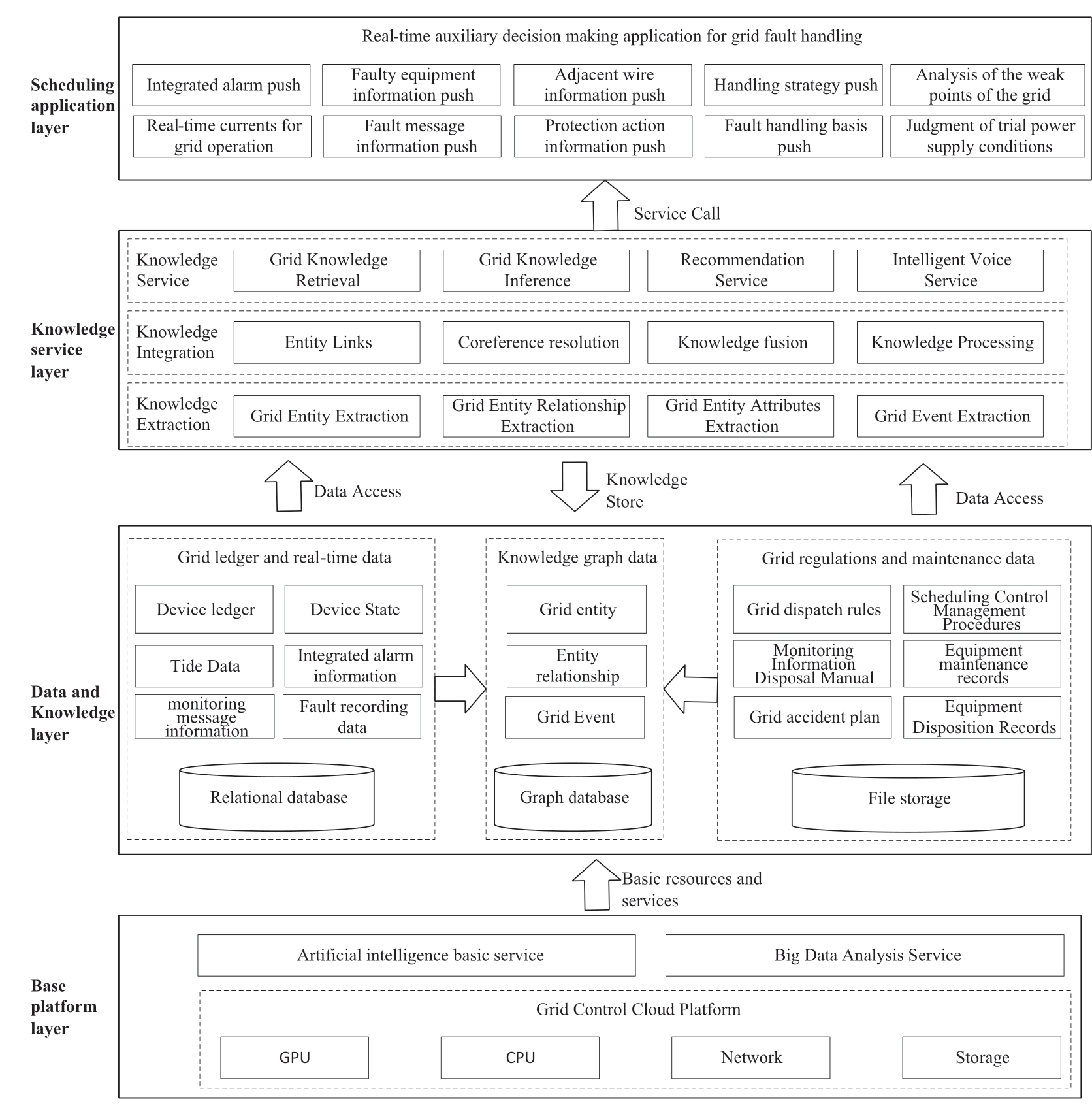
Fig. 5 Overall system architecture
The knowledge-graph-based power-grid faulthandling auxiliary decision-making system provides two core functions: knowledge management and power-grid fault-handling auxiliary decision-making. Knowledge management involves the management, updating, and querying of knowledge related to grid dispatch fault handling and continuously adds and stores new faulthandling knowledge. Grid fault-handling auxiliary decision-making accesses the real-time fault data of the grid, performs fault-handling knowledge reasoning based on a grid fault-handling knowledge graph, and provides intelligent auxiliary decision-making support to dispatchers.
The system integrates and displays basic data such as grid equipment fault information, adjacent line information,fault message information, and relevant protection actions.It forms a fault-handling strategy through knowledge reasoning and performs fault-handling based on information,including dispatch rules, dispatch plans, and other requirements. The system provides a weak-point analysis function to analyze weak lines and nodes and pushes the results to the dispatcher to assist in fault handling.
4 Experiment on the Knowledge Extraction Model and Application of Fault Handling Aid Decision System
4.1 Knowledge extraction model experiments
To verify the effectiveness of the entity identification and RE model for grid dispatch fault handling, we performed experiments with the ERNIE-BiLSTM-CRF,BERT-BiLSTM-CRF, and BiLSTM-CRF models for the same training dataset, testing dataset, hardware, and software environments. The environment, configuration,and parameter settings of the model training are presented in Tables 2 and 3.
Table 2 Model training environment and configuration
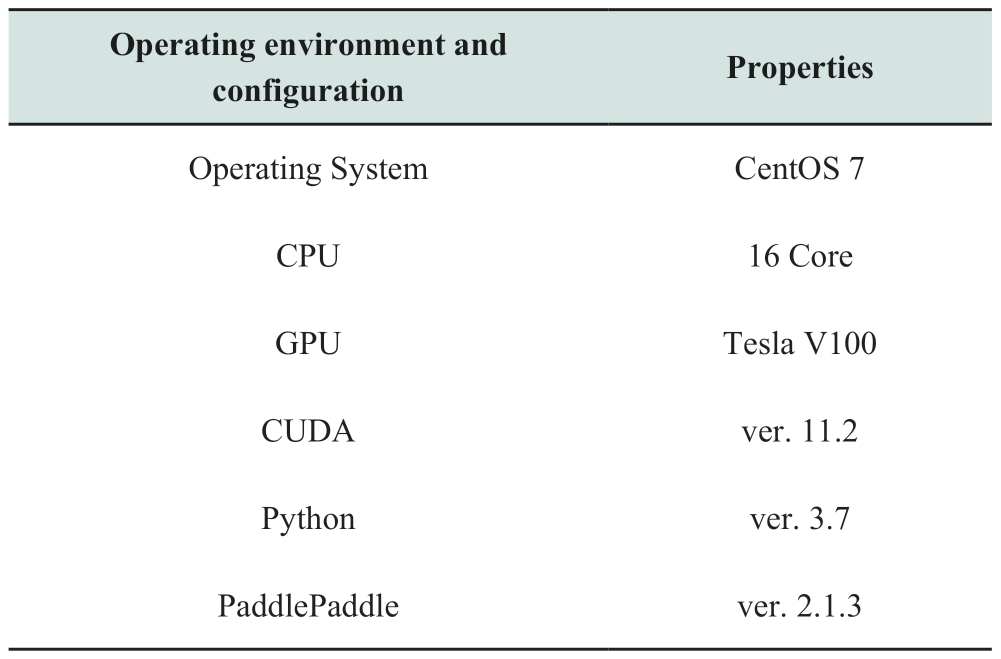
Table 3 Model training parameter setting
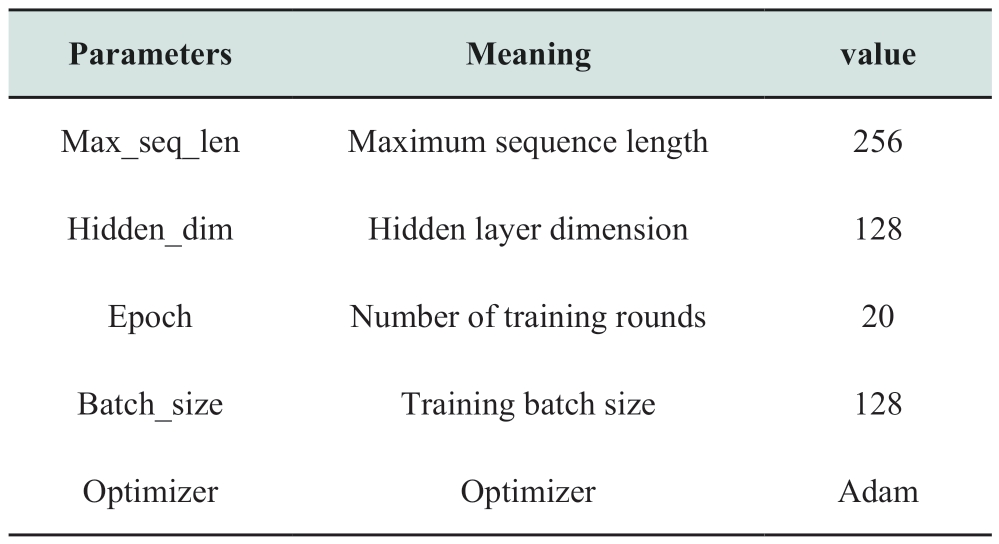
Correctness, recall, and F-values were used to evaluate the model performance. The formula is shown in equation 21-23.

The dataset was manually annotated by tuning the gauge text sequence data such that the maximum sequence length did not exceed 128 words. The dataset was divided into training and test sets, with 85% and 15% of the data used as the training and test sets, respectively.
Fig. 6 shows the change in the F1 scores of the models during the training process of the entity identification task.Fig. 7 shows the change in the F1 scores of the models during the training process of the RE task.
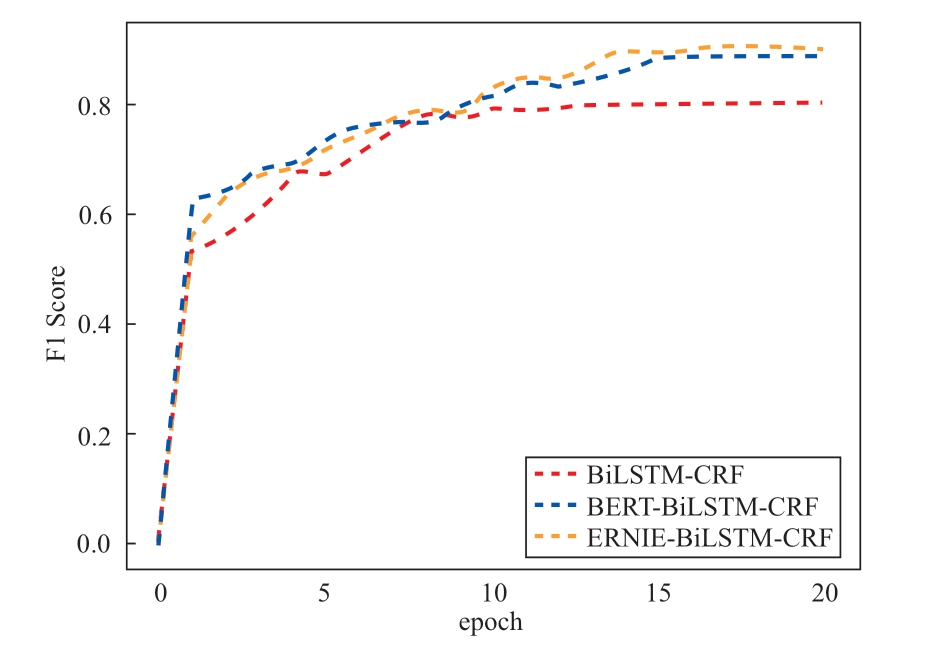
Fig. 6 F1 Score of models on NER task during training
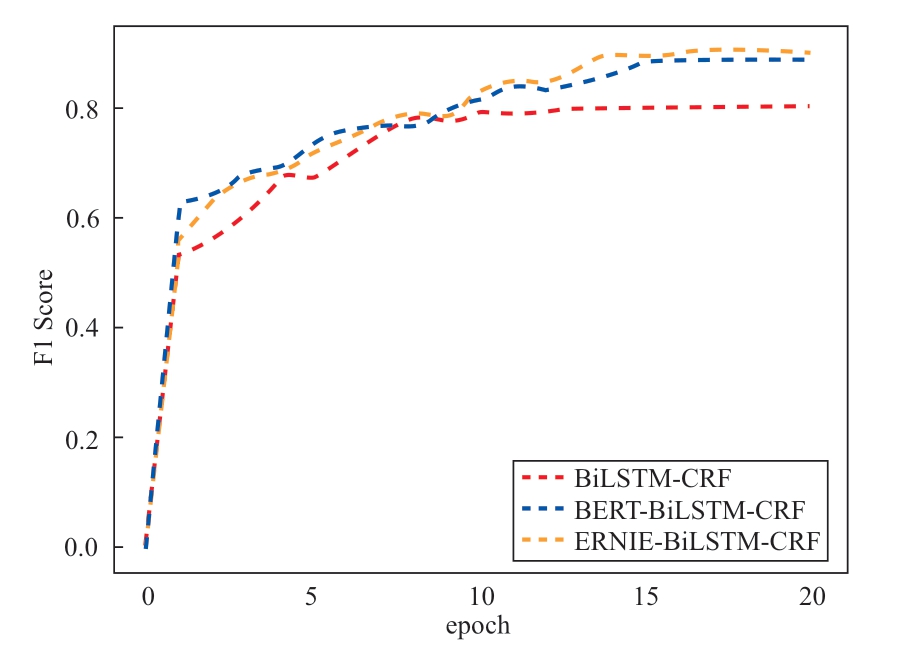
Fig. 7 F1 Score of models on RE task during training
The results of entity identification and RE on the test set are shown in Tables 4 and 5, respectively.
Table 4 Entity identification test results
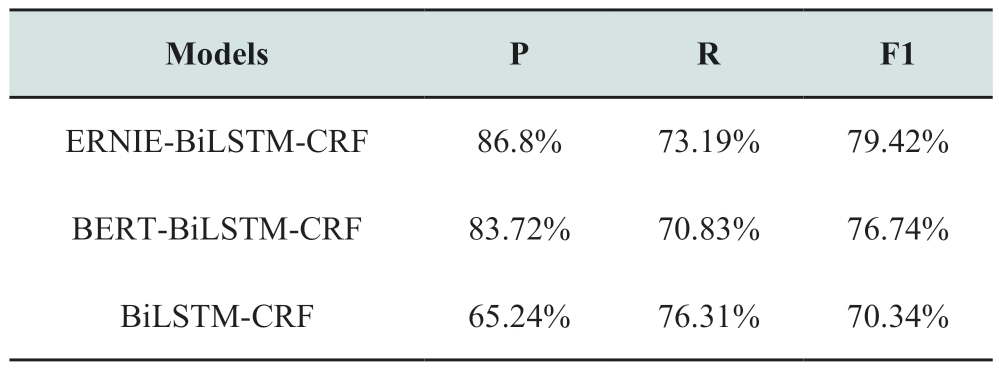
Table 5 Relationship extraction test results
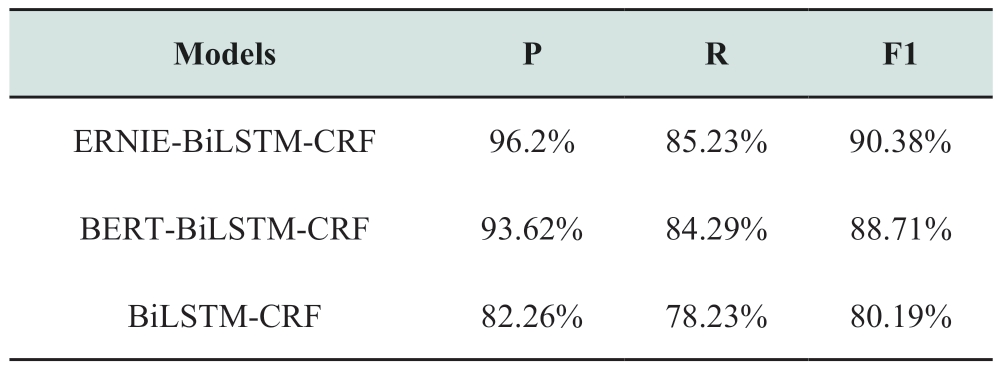
The experimental results showed that the method based on the pre-trained ERNIE model had greater advantages,and the integrated index F-value in the entity identification and RE tasks improved by nearly ten percent compared with the BiLSTM-CRF model and approximately two percent compared with the BERT-BiLSTM-CRF model, which can effectively support the construction of a power dispatch knowledge graph.
4.2 Application of power-grid fault-handling aid decision system
In this study, the ERNIE-BiLSTM-CRF model was used to extract entities and relationships using grid dispatch fault-handling data. After entity linking and knowledge complementation, a knowledge graph construction of the grid dispatch fault-handling domain containing 160,000 entities and 547,000 relationships was constructed for knowledge precipitation, inheritance, and utilization in the grid dispatch fault-handling domain. Part of the visualization display of the knowledge graph is shown in Fig. 8.
Based on the knowledge graph, an auxiliary decisionmaking application for power-grid fault handling was developed. Taking line faults as an example, the specific processing is shown in Fig. 9.
(1) When a fault occurs, the system first receives fault message information, including the time, location, and alarm content. For example, “Lianhua Station, circuit breaker, 500 kV, 2019-11-08 11:48:06500 kV. Liankai Line 5051 switch interval accident signal, action.” The system extracts relevant key information such as lines, stations,switches, and protections through text analysis and forms the core knowledge-structured data in the form of multiple groups. For example, “Date: November 8, 2019 11:48:06,Factory Station: Lianhua Station, Equipment: Liankai First Line, 5051 Switch Bay, Attribute: Accident Signal, Status:Reset, Signal Type: Accident.”
(2) Based on structured information, a logical judgment of entities and relationships is conducted in the entity graph, achieving the screening and integration of types of information, such as faults, displacement, and anomalies,and further matching the requirements of disposal plans,scheduling rules, and other rules to obtain the necessary precautions, operating rules, operating principles, and special requirements. For example, “if N-1 fault analysis poses a threat to the safe and stable operation of the power grid, determine whether forced transmission is allowed based on the conditions for severe faults.”
(3) A knowledge search and inference is conducted based on the current operating status of the power grid, and knowledge extraction and verification related to faults are performed. After matching and verifying the knowledge of scheduling regulations, fault-type knowledge inference is performed, the status of switch rejection and misoperation,reclosing, and main protection action are analyzed, and a preliminary judgment of fault type is conducted. A preliminary fault report, including the fault time, fault line,switch opening and closing positions of the stations on both sides of the line, main protection action, reclosing action,and fault location, supports the preliminary fault analysis.
(4) Knowledge inference is conducted on the trial transmission conditions of line tripping based on prior knowledge and scheduling regulations. It primarily infers and determines the protection action scenario, high impedance, series compensation alarm information, and abnormal alarm signals of the primary and secondary equipment, and pushes the trial transmission judgment results to the dispatcher. For example, “Allow forced transmission of faulty lines.”
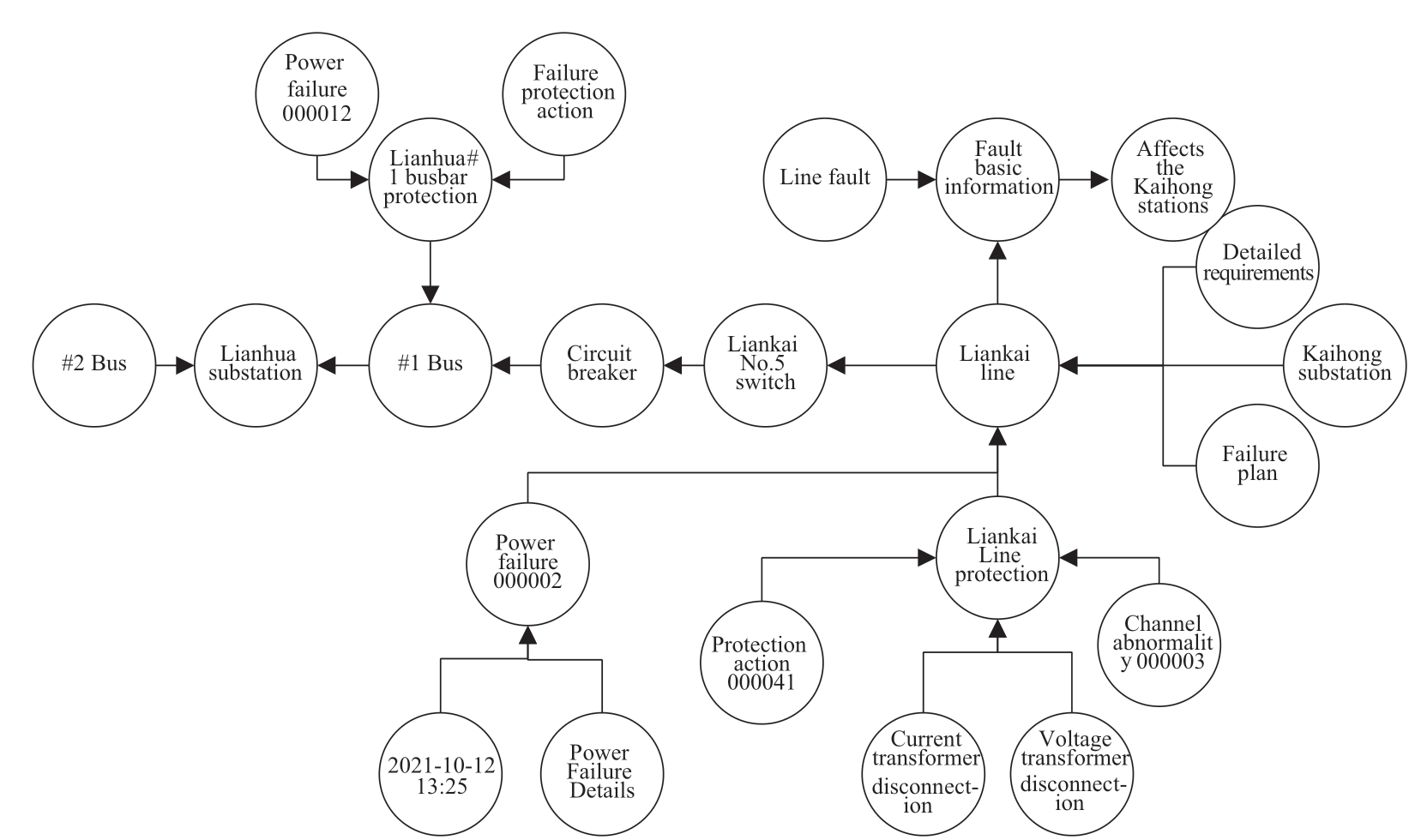
Fig. 8 Visualization display of the knowledge graph
(5) After the conditions for the trial transmission of the line are satisfied, knowledge reasoning for the selection of the trial transmission end is performed according to the scheduling regulations. According to the judgment principles of the adjustment design, such as station type,small-area scenario, and topology of the connection between the station and line, a trial transmission end that satisfies the requirements of the regulations is pushed. For example,“Force delivery is allowed on the Liankai front line, with the force delivery end selected at Taiping Station.”
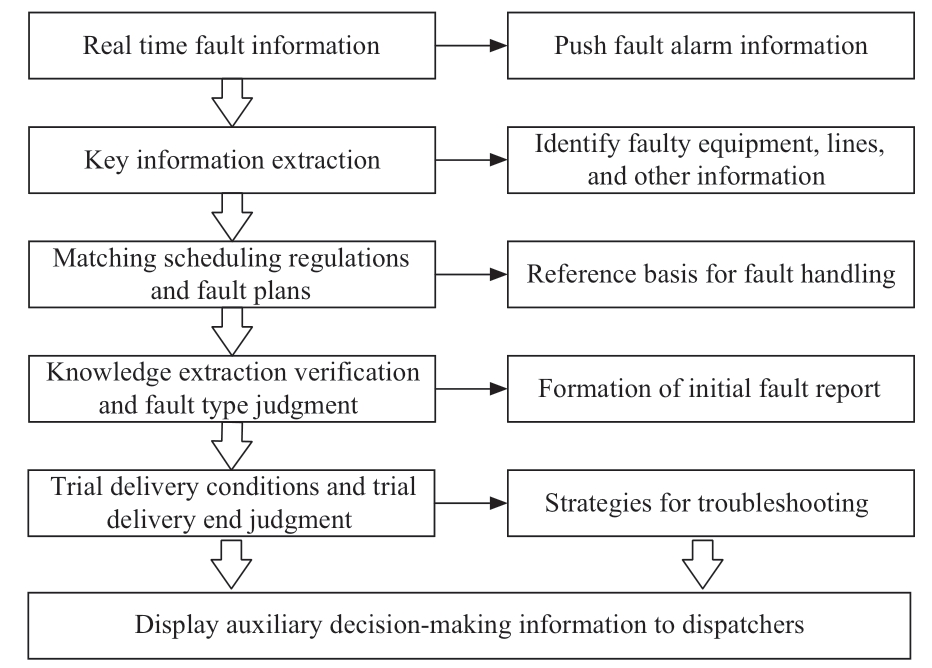
Fig. 9 Fault handling flowchart
The system was deployed in a power-grid dispatch control center of a provincial power company. It provided intelligent auxiliary decision support for the dispatcher to handle faults.Through the accumulation, solidification, and inheritance of knowledge in the field of power-grid fault handling, the problems of low accuracy and timeliness in fault handling caused by the differences and scarcity of knowledge reserves among dispatchers were resolved. The fault inference time was compressed to approximately ten seconds, significantly improving the efficiency of fault handling decision-making compared with traditional manual processing methods, and effectively reducing the power outage time. This method transforms the previous paradigm of relying solely on the experience of dispatchers for analysis and processing into a work mode dominated by intelligent methods and supplemented by manual audits, thereby improving the ability to handle power grid accidents.
5 Conclusion
In this paper, based on multiple heterogeneous grid fault-handling data and the application of knowledge graph technology in artificial intelligence, we study the intelligent grid dispatch fault-handling technology in depth.
(1) A pre-trained model-based knowledge extraction method for grid dispatch faults is proposed, and an ERNIEBiLSTM-CRF model is constructed to improve the accuracy of the knowledge extraction model and support the knowledge extraction of grid dispatch text data entities and relationships.
(2) A fault-handling ontology model is designed by integrating the knowledge of the grid-dispatch business,and a knowledge graph of grid-dispatch fault handling is constructed to achieve knowledge precipitation,accumulation, and service.
(3) We develop a knowledge-graph-based powergrid dispatch fault-handling auxiliary decision system that provides intelligent auxiliary decision support for dispatchers, improves dispatchers’ ability to handle power grid accidents, and comprehensively enhances the power grid safety control level.
In the next research, we will combine grid dispatch multi-source heterogeneous data, continuously expand the dispatch fault-handling knowledge graph, improve intelligent voice, intelligent recommendations, and other functions, enhance the interactive capability and intelligence level of grid dispatch fault handling, and support the construction of new power systems.
Acknowledgements
This work was supported by the Science and Technology Project of the State Grid Corporation “Research on Key Technologies of Power Artificial Intelligence Open Platform” (5700-202155260A-0-0-00).
Declaration of Competing Interest
We declare that we have no conflict of interest.
References
[1] Xu Z, Sheng Y, He L, et al. (2016) A review of knowledge graph technology. Journal of the University of Electronic Science and Technology, 45(4): 589-606
[2] Liu H, Li Y, Duan H, et al. (2016) A review of knowledge graph construction techniques. Computer Research and Development,53(3): 582-600
[3] Li X, Xu J, Guo Z, et al. (2019) Construction and application of knowledge graph for dispatch automation system. China Electric Power, 52(2): 70-77, 157
[4] Yu J, Wang X, Zhang Y, et al. (2020) Construction and application of knowledge graph for intelligent regulation and control. Power System Protection and Control, 48(3): 29-35
[5] Wu C (2020) Design and implementation of knowledge extraction system in power dispatch knowledge graph. University of Chinese Academy of Sciences
[6] Zhai S, Duan H, Li Z (2019) A knowledge graph entity extraction method based on BILSTM_CRF. Computer Applications and Software, 36(5): 269-274, 280
[7] Wang J, Yang J, Pei Y, et al. (2021) Research on distribution network fault-aided decision making based on knowledge mapping. Power Grid Technology, 45(6): 2101-2112
[8] Li G, Li Y, Wang H, et al. (2022) Knowledge mapping of power equipment health management: basic concepts, key technologies and research progress. Power System Automation, 46(3): 1-13
[9] Dong L, Bai L, Wu N, et al. (2022) Research on power transformer fault prediction method based on knowledge mapping. High Voltage Electronics, 58(11): 151-159
[10] Liu Z,Wang H (2018) A method for retrieving defect records of power equipment based on knowledge graph technology. Power System Automation, 42(14): 158-164
[11] Meng F, Yang S, Wang J, et al. (2022) Creating knowledge graph of electric power equipment faults based on BERT–BiLSTM–CRF model. Journal of Electrical Engineering & Technology,17(4): 2507-2516
[12] Zhang X, Li Y, Wang D, et al. (2020) Named entity recognition based on ERNIE. Intelligent Computers and Applications, 10(3):21-26
[13] Luo R, Xia J (2022) Fusion of ERNIE and improved transformer for chinese NER model. Computer Technology and Development,32(10): 120-125
[14] Yang F, Huang H, Li H, et al. (2022) A text mining method for power equipment defects based on ERNIE pre-trained. Electrical Transmission, 52(14): 52-58
[15] Jason C, Eric N (2015) Named entity recognition with bidirectional lstm-cnns. arXiv, 1511-1530
[16] Mi L,Yuan J (2020) Research on the application of CRF modelbased entity recognition method for clinical medical advice information. Computer Application and Software, 37(3): 209-212
[17] Xu J, Zhu J, Zhao R, et al. (2017) Space named entity identification based on CRF algorithm. Electronic Design Engineering, 25(20):42-46
[18] Yan X, Duan Y X, Zhang Z H (2020) Entity relationship extraction using self-attentive mechanism and CNN fusion.Computer Engineering and Science, 42(11): 2059-2066
[19] Liu YP, Li DD (2020) A BLSTM-CNN-CRF based Chinese named entity recognition method. Journal of Harbin University of Technology, 25(1): 115-120
[20] Hochreiter S, Schmidhuber J (1997) Long short-term emory.Neural Computation, 9(8): 1735-1780
[21] Cheng C, Hong T, Xue S (2019) BLSTM_MLPCNN model for short text classification. Computer Science, 6: 206-211
[22] Rekia K (2018) CCG Hyper-Annotation Based on Deep Learning Model. Dissertation, Harbin Institute of Technology
[23] An C, Huang J, Chang S, et al. (2016) Question similarity modeling with bidirectional long short-term memory neural network. 2016 IEEE First International Conference on Data Science in Cyberspace, Changsha, Hunan, China, 318-322
[24] Anupama R, Sai R, Santanu C (2015) Text recognition using deep BLSTM networks. 2015 Eighth International Conference on Advances in Pattern Recognition, Kolkata, India, 1-6
Received: 23 February 2023/ Accepted: 7 July 2023/ Published: 25 August 2023
 Zhixiang Ji
Zhixiang Ji
jizhixiang@epri.sgcc.com.cn
Xiaohui Wang
wangxiaohui@epri.sgcc.com.cn
Jie Zhang
18161273371@163.com
Di Wu
wudi@epri.sgcc.com.cn
2096-5117/© 2023 Global Energy Interconnection Development and Cooperation Organization. Production and hosting by Elsevier B.V. on behalf of KeAi Communications Co., Ltd. This is an open access article under the CC BY-NC-ND license (http: //creativecommons.org/licenses/by-nc-nd/4.0/ ).
Biographies

Zhixiang Ji received a master’s degree at Harbin Institute of Technology, Nangang District, Harbin, in 2011. He is with the China Electric Power Research Institute Co. Ltd.,Haidian District, Beijing. His research interests include power AI applications, knowledge atlas, and natural language processing.

Xiaohui Wang received a doctor’s degree at North China Electric Power University,Beijing, in 2012. He is with the China Electric Power Research Institute Co. Ltd., Haidian District, Beijing. His research interests include power artificial intelligence, active distributed network, and energy Internet.

Jie Zhang received a master’s degree at the University of Electronic Science and Technology of China, Chengdu, in 2008.He is with Sichuan Electric Power Research Institute SGCC. His research interests are power artificial intelligence, big data, and other technologies.

Di Wu received a master’s degree at Peking University, Haidian District, Beijing, 2019. He is with China Electric Power Research Institute Co. Ltd., Haidian District, Beijing. His research interests are natural language processing and application of artificial intelligence technology in power systems.
(Editor Yanbo Wang)
